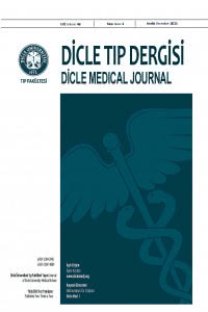İmatinib tedavisi alan kronik myeloid lösemi hastalarında tedavi etkinliğinin ve prognozun değerlendirilmesi
Evaluation of efficacy of treatment and prognosis in chronic myeloid leukemia patients treated with imatinib
___
- Fialkow PJ, Jacobson RJ, Papayannopoulou T.Chronic myelocyticleukemia: clonalorigin in a stemcell common to the granulocyte, erythrocyte, platelet and monocyte/ macrophage. Am J Med, 1977. 63: 125–30.
- Faderl S, Talpaz M, Estrov Z ve ark. The biology of chronicmyeloid leukemia. N Engl J Med, 1999. 341: p. 164-72.
- Sawyers CL, Chronic myeloid leukemia. N Engl J Med, 1999; 340 : p. 1330-40.
- Bennett J, Case of hypertrophy of the spleen liver, in which death took place from suppuration of the blood. Edinb. Med. Surg. J, 1845; 64: p. 413-23.
- Nowell P, Hungerford D. "A minute chromosome in chronic granulocytic leukemia." Science 1960; 132: 1497.
- Rowley JD. A new consistent chromosomalab normality in chronic myelogenous leukaemia identified by quinacrine fluorescence and Giemsa staining. Nature, 1973; 243:290-3.
- Goldman JM, Melo JV. Chronic myeloid leukemiaadvances in biology and new approaches to treatment. N.Engl J Med, 2003. 349:1451-64.
- Deininger MW, Goldman JM ve Melo JV. The molecular biology of chronic myeloid leukemia. Blood, 2000; 96: p. 3343-56.
- Tefferi A, Thiele J, Orazi A ve ark. Proposals and rationale for revision of the World Health Organization diagnostic criteria for polycythemia vera, essential thrombocythemia, and primary myelofibrosis: recommendations from an ad hoc internationalexpert panel. Blood, 2007; 110: 1092–7.
- Cortes JE, Talpaz M, Beran M ve ark. Philadelphia chromosome-negative chronic myelogenous leukemia with rearrangement of the break point cluster region. Long-term follow-upresults. Cancer, 1995; 75: p. 464- 70.
- Garcia-Manero G, Talpaz M ve Kantarjian HM. Current therapy of chronic myelogenous leukemia. Intern Med, 2002. 41: p. 254-64.
- The Italian Cooperative Study Group on Chronic Myeloid Leukemia. Interferon alfa-2a as compared with conventional chemotherapy for the treatment of chronic myeloid leukemia. N Engl J Med, 1994; 330: p. 820-5.
- Carolina P, Kantarjian HM, Cortes JE. Firstlinetherapy for chronic myeloid leukemia: past, present, and future. Am. J. Hematol, 2009; 84: 287–93.
- de Lavallade H, Apperley JF, Khorashad JS ve ark. Imatinib for new lydiagnosed patients with chronic myeloid leukemia: incidence of sustained responses in an intention-to-treatanalysis. J Clin Oncol. 2008; 26: 3358-63.
- Yasuhito Nannya, Hiromitsu Yokota, Yumiko Sato ve ark. Molecular and cytogenetic response of chronic myelogenous leukemia treated with imatinib mesylate: one institutiona experience in Japan. Int J Hematol. 2008; 88: 159–64.
- E Yanmin Zhao, Lizhen Liu, Yingjia Wang ve ark. Efficacyand prognosis of chronic myeloid leukemia treated with imatinib mesylate in a Chinese population. Int J Hematol. 2009; 89: 445–51.
- Palandri F, Castagnetti F, Testoni Nve ark. Chronic myeloid leukemia in blast crisis treated with imatinib 600 mg: outcome of the patients alive after a 6-year followup. Haematologica. 2008, 93: 1792-6.
- Lee JP, Birnstein E, Masiello D ve ark. Gender and ethnic differences in chronic myelogenous leukemia prognosis and treatment response: a single institution retrospective study. J Hematol Oncol. 2009; 2: 30.
- Matsuo E, Miyazaki Y, Tsutsumi C ve ark. Imatinib provides durable molecular and cytogenetic responses in a practical setting for both newly diagnosed and previously treated chronic myelogenous leukemia: a study in nagasaki prefecture, Japan. Int J Hematol. 2007;85: 132-9.
- Baccarani M, Saglio G, Goldman J ve ark. Evolving concepts in the management of chronic myeloid leukemia: recommendations from an expert panel on behalf of the European Leukemia Net. Blood. 2006 Sep 15; 108: 1809-20.
- ISSN: 1300-2945
- Yayın Aralığı: 4
- Başlangıç: 1963
- Yayıncı: Cahfer GÜLOĞLU
Muhammet Hulusi SATILMIŞOĞLU, Mehmet GÜL, Hüseyin Altuğ ÇAKMAK, NİLGÜN IŞIKSAÇAN, Selahattin TÜREN, Uğur KÖKTÜRK, Emre YILMAZ, Muammer KARAKAYALI, Aydın Rodi TOSU
Çocukluk Çağında Atipik Hemolitik Üremik Sendrom
BELTİNGE DEMİRCİOĞLU KILIÇ, Mehtap AKBALIK KARA
Extracranial and intracranial artery dissections: Experiences from a tertiary referral center
Çiğdem DENİZ, Talip ASİL, ABDÜLKADİR TUNÇ
Mehmet Cihan Yavaş, Uğur Şeker, İsmail Yıldız, Veysi Akpolat, Engin Deveci, Hakkı Murat Bilgin, İbrahim Kaplan, Mehmet Esref Alkış, Mustafa Salih Çelik, Mehmet Zülküf Akdağ
Adölesanlarda varyant anjina: Kardiyak bilgisayarlı tomografinin kullanımı ve literatür taraması
Hayrullah ALP, Esma Keleş ALP, Ahmet Midhat ELMACI
Kliniğimize Başvuran Mol Gebelik Olgularının Retrospektif İncelenmesi
MERT ULAŞ BARUT, Sibel SAK, Muhammet Erdal SAK
Kahverengi yağ dokusundaki karbonik anhidraz III ekspresyonu ve oksidatif stress arasındaki ilişki
Ayşe ŞENTÜRK, Cemil KAHRAMAN, Ahmet ALVER, İmran İNCE AKÇA
Ekstrakraniyal ve intrakraniyal arter diseksiyonları: Bir üçüncü basamak merkezinden deneyimler
Talip ASİL, Çiğdem DENİZ, Abdulkadir TUNÇ
Mesut ENGİN, MEHMET TUĞRUL GÖNCÜ, Orhan GÜVENÇ, Muhammed SAVRAN, AHMET FATİH ÖZYAZICIOĞLU
